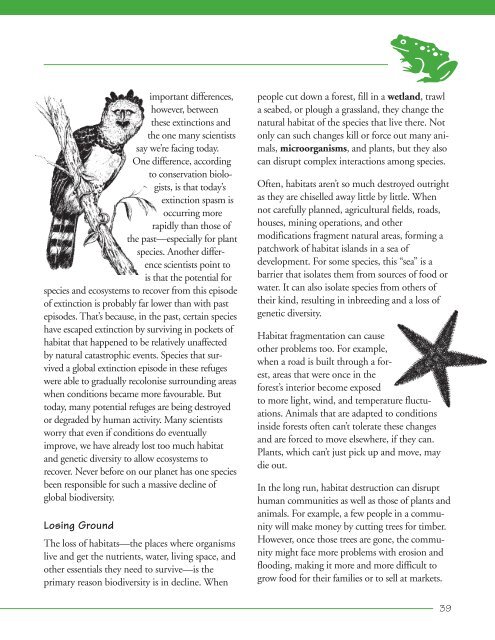EXPLORING BIODIVERSITY: A Guide for Educators Around the World
EXPLORING BIODIVERSITY: A Guide for Educators Around the World
EXPLORING BIODIVERSITY: A Guide for Educators Around the World
You also want an ePaper? Increase the reach of your titles
YUMPU automatically turns print PDFs into web optimized ePapers that Google loves.
q<br />
important differences,<br />
however, between<br />
<strong>the</strong>se extinctions and<br />
<strong>the</strong> one many scientists<br />
say we’re facing today.<br />
One difference, according<br />
to conservation biologists,<br />
is that today’s<br />
extinction spasm is<br />
occurring more<br />
rapidly than those of<br />
<strong>the</strong> past—especially <strong>for</strong> plant<br />
species. Ano<strong>the</strong>r difference<br />
scientists point to<br />
is that <strong>the</strong> potential <strong>for</strong><br />
species and ecosystems to recover from this episode<br />
of extinction is probably far lower than with past<br />
episodes. That’s because, in <strong>the</strong> past, certain species<br />
have escaped extinction by surviving in pockets of<br />
habitat that happened to be relatively unaffected<br />
by natural catastrophic events. Species that survived<br />
a global extinction episode in <strong>the</strong>se refuges<br />
were able to gradually recolonise surrounding areas<br />
when conditions became more favourable. But<br />
today, many potential refuges are being destroyed<br />
or degraded by human activity. Many scientists<br />
worry that even if conditions do eventually<br />
improve, we have already lost too much habitat<br />
and genetic diversity to allow ecosystems to<br />
recover. Never be<strong>for</strong>e on our planet has one species<br />
been responsible <strong>for</strong> such a massive decline of<br />
global biodiversity.<br />
Losing Ground<br />
The loss of habitats—<strong>the</strong> places where organisms<br />
live and get <strong>the</strong> nutrients, water, living space, and<br />
o<strong>the</strong>r essentials <strong>the</strong>y need to survive—is <strong>the</strong><br />
primary reason biodiversity is in decline. When<br />
people cut down a <strong>for</strong>est, fill in a wetland, trawl<br />
a seabed, or plough a grassland, <strong>the</strong>y change <strong>the</strong><br />
natural habitat of <strong>the</strong> species that live <strong>the</strong>re. Not<br />
only can such changes kill or <strong>for</strong>ce out many animals,<br />
microorganisms, and plants, but <strong>the</strong>y also<br />
can disrupt complex interactions among species.<br />
Often, habitats aren’t so much destroyed outright<br />
as <strong>the</strong>y are chiselled away little by little. When<br />
not carefully planned, agricultural fields, roads,<br />
houses, mining operations, and o<strong>the</strong>r<br />
modifications fragment natural areas, <strong>for</strong>ming a<br />
patchwork of habitat islands in a sea of<br />
development. For some species, this “sea” is a<br />
barrier that isolates <strong>the</strong>m from sources of food or<br />
water. It can also isolate species from o<strong>the</strong>rs of<br />
<strong>the</strong>ir kind, resulting in inbreeding and a loss of<br />
genetic diversity.<br />
Habitat fragmentation can cause<br />
o<strong>the</strong>r problems too. For example,<br />
when a road is built through a <strong>for</strong>est,<br />
areas that were once in <strong>the</strong><br />
<strong>for</strong>est’s interior become exposed<br />
to more light, wind, and temperature fluctuations.<br />
Animals that are adapted to conditions<br />
inside <strong>for</strong>ests often can’t tolerate <strong>the</strong>se changes<br />
and are <strong>for</strong>ced to move elsewhere, if <strong>the</strong>y can.<br />
Plants, which can’t just pick up and move, may<br />
die out.<br />
In <strong>the</strong> long run, habitat destruction can disrupt<br />
human communities as well as those of plants and<br />
animals. For example, a few people in a community<br />
will make money by cutting trees <strong>for</strong> timber.<br />
However, once those trees are gone, <strong>the</strong> community<br />
might face more problems with erosion and<br />
flooding, making it more and more difficult to<br />
grow food <strong>for</strong> <strong>the</strong>ir families or to sell at markets.<br />
39

















